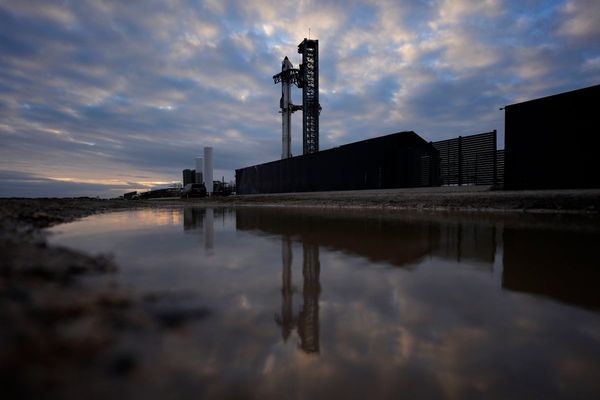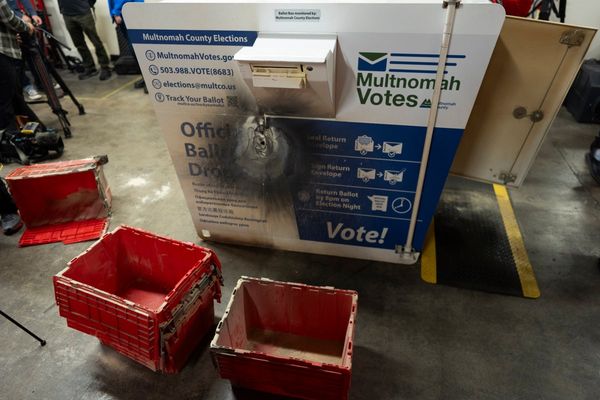
An IBM worker walks inside the company’s 12-inch wafer chip fabricating plant in Fishkill, New York, on July 20, 2004. Mario Tama/Getty Images
In 2011, then-President Barack Obama attended an intimate dinner in Silicon Valley. At one point, he turned to the man on his left. What would it take, Obama asked Steve Jobs, for Apple to manufacture its iPhones in the United States instead of China? Jobs was unequivocal: “Those jobs aren’t coming back.” Jobs’s prognostication has become almost an article of faith among policymakers and corporate leaders throughout the United States. Yet China’s recent weaponization of supply chains and information networks exposes the grave dangers of the American deindustrialization that Jobs accepted as inevitable.
Since March alone, China has threatened to withhold medical equipment from the United States and Europe during the coronavirus pandemic; launched the biggest cyberattack against Australia in the country’s history; hacked U.S. firms to acquire secrets related to the coronavirus vaccine; and engaged in massive disinformation campaigns on a global scale. China even hacked the Vatican. These incidents reflect the power China wields through its control of supply chains and information hardware. They show the peril of ceding control of vast swaths of the world’s manufacturing to a regime that builds at home, and exports abroad, a model of governance that is fundamentally in conflict with American values and democracies everywhere. And they pale in comparison to what China will have the capacity to do as its confrontation with the United States sharpens.
In this new cold war, a deindustrialized United States is a disarmed United States—a country that is precariously vulnerable to coercion, espionage, and foreign interference. Preserving American preeminence will require reconstituting a national manufacturing arrangement that is both safe and reliable—particularly in critical high-tech sectors. If the United States is to secure its supply chains and information networks against Chinese attacks, it needs to reindustrialize. The question today is not whether America’s manufacturing jobs can return, but whether America can afford not to bring them back.
America’s superpower might was made on the factory floor. The nation’s vast industrial capacity carried it to victory in World War II and gave it a commanding advantage over the Soviet Union. As recently as the early 2000s, iMacs—a symbol of American high-tech dominance—were still made in Elk Grove, California. But since the 1970s, more than 7 million American manufacturing jobs have evaporated—over a third of the country’s entire manufacturing workforce. In the first decade of the 21st century, more than 66,000 manufacturing facilities closed down or moved overseas. America’s share of the world’s printed circuit board production has dropped 70 percent since 2000; China accounts for around half of global production today. The high-tech industry is hardly exempt: As of 2015, Chinese factories produced 28 percent of the world’s cars, 41 percent of ships, more than 60 percent of TVs, and a staggering 90 percent of the world’s mobile phones. Indeed, Apple’s Elk Grove plant is now an AppleCare call center.
- Plant workers gather after hearing that their metalworking company, Revere Copper Products Inc., in New Bedford, Massachusetts, will close March 6, 2007. The company, founded by Paul Revere, once provided copper sheathing for the city’s whaling fleet but shut down because of foreign competition. Peter Pereira/The New Bedford Standard Times/The Associated Press
- Apple employees work on iMac computers at an Apple manufacturing plant in Sacramento, California, on May 24, 1999. Getty Images
At the same time, a new Silicon Curtain has begun to descend. As FBI Director Christopher Wray recently pointed out, China does not seek a world where its companies lead alongside other global companies but one where its companies exploit a domestic monopoly at home to drive other companies out of business everywhere else. In the energy sector, China’s vast web of state subsidies supporting its domestic solar-electric industry dropped world prices of solar panels by 80 percent between 2008 and 2013. A report by the U.S. Senate Foreign Relations Committee echoed this trend in more cutting-edge technologies: “Foreign technology platforms are restricted from operating in China, allowing Chinese platforms that offer similar services to thrive and expand into new markets.” The report also highlighted examples of Chinese “national champions” expanding internationally thanks to unfair government support and subsidies, noting, “Huawei’s price was so low that, absent the subsidies the company had been provided, Huawei would have been unable to even produce the necessary network parts.” Beijing’s “Made in China 2025” initiative outlines in blunt terms China’s ambitions for dominance in artificial intelligence, robotics, aerospace equipment, and biopharmaceuticals—high-tech industries that represent the future of the global economy.
The United States’ industrial overdependence on China poses two profound national security threats. The first is about access to the supply of critical goods. As I warned in June, U.S.-China relations are now more volatile than at any time since Tiananmen, and it is an open question whether decoupling will be slow and soft or hard and fast. As the bilateral relationship further deteriorates, American companies face a growing risk of experiencing sudden delays or disruptions to their supply chains, either as an overt retaliation by the Chinese Communist Party (CCP) to U.S. policies or in the form of gray-zone tactics to kneecap U.S. companies and promote Chinese alternatives to fill the void in the global supply for key goods.
This risk, once deemed far-fetched, recently came to life when Arm, a U.K.-based chip designer, recently appeared to have suddenly lost control of its China-based joint-venture subsidiary, Arm China. As Business Insider reported, “Arm fired Allen Wu, the head of Arm China, but Wu refused to acknowledge the decision and has continued overseeing operations of the business unit, according to Bloomberg. Arm China also reportedly won’t let members of the UK parent entity onto its premises.” It has been seven years since the Alliance for American Manufacturing released a list of critical military hardware, with both offensive and defensive applications, that are susceptible to supply chain interference. American missiles depend on Chinese propellant; American night-vision goggles depend on Chinese metal.
Clockwise from top left: An employee works on a cylinder production line at a factory in Hangzhou, China, on Jan. 17; workers produce medical supplies at a factory in Binzhou, China, on Feb. 13; a quality-control worker checks a pod on the production line for the e-cigarette company Myst Labs in Shenzhen, China, on Sept. 25, 2019; and a worker checks chip component circuits at the Oppo smartphone factory in Dongguan, China, on May 18, 2017. STR/AFP via Getty Images; STR/AFP via Getty Images; Kevin Frayer/Getty Images; NICOLAS ASFOURI/AFP via Getty Images
During the pandemic, the Chinese government is also believed to have given preferential treatment to its domestic semiconductor companies, allowing Yangtze Memory Technologies to continue operating, all the while requiring all foreign-based chip makers, such as Samsung, to completely halt their operations. This is what political scientists have dubbed “weaponized interdependence”—exploiting control of critical nodes in the global economy to exert geopolitical leverage over one’s competitors.
The second risk of U.S. industrial dependence on China is about the integrity of powerful dual-use commercial technology products: civilian goods such as information platforms, social network technology, facial recognition systems, cellphones, and computers that also have powerful military or intelligence implications. These products are increasingly becoming a “perfect weapon” for U.S. adversaries such as Russia and China that continuously seek asymmetric ways to weaken the United States. The Senate Foreign Relations Committee report noted, “the suites of new and emergent digital technologies … —including 5G infrastructure, social media, block-chain, digital surveillance, and genomics and biotechnology—are all widely acknowledged as being on the cutting edge of this new competition.” China’s command over critical nodes of the world’s supply chains provides it with vast strategic leverage over the integrity of critical hardware products.
A 2018 Bloomberg investigation reported that Chinese operatives had inserted a miniscule microchip into the servers of Supermicro, a company whose systems are used by institutions ranging from major banks to the Pentagon. Though all parties involved denied that such a breach occurred, even the possibility of such a hardware hack sent shudders through Silicon Valley and the U.S. national security apparatus. Even if disputed, the report laid bare the dangers of outsourcing American manufacturing to an American adversary.
Public concerns over the integrity of Chinese-built technology systems recently reached a boiling point in the software world, with the U.S. government calling on ByteDance, a Beijing-based global technology company, to divest from TikTok, its U.S. subsidiary. In some cases, senior government officials, ranging from President Donald Trump to Senate Democratic Leader Chuck Schumer, went as far as floating the possibility of a complete suspension of the app.
- A worker packs up new smartphone devices at the end of the production line at Huawei’s production campus in Dongguan, China, on April 11, 2019. Huawei has faced allegations that its equipment includes so-called back doors that the U.S. government perceives as a national security risk. Kevin Frayer/Getty Images
- An employee walks outside the headquarters of ByteDance, the owner of the video-sharing app TikTok, in Beijing on Aug. 5. NOEL CELIS/AFP via Getty Images
The public’s justified concerns trace back to China’s civil-military fusion doctrine, which blurs the line between the CCP and China’s private sector. Under China’s 2017 National Intelligence Law, the CCP could compel an individual engineering employee at TikTok based in China to provide the party with intelligence assistance and keep that assistance entirely confidential, without any of TikTok’s U.S.-based executives even being aware.
In effect, this means companies based in China could be subject to a dual reporting and corporate governance structure—their company’s executives on the one hand, and, on the other, a shadow governance structure reporting to officials from the Chinese Communist Party. China-based companies must effectively answer to two masters. Arm’s U.K.-based executives learned this the hard way. But the principles were spelled out in broad daylight by Chinese President Xi Jinping himself when he compared the relationship between Chinese citizens and the CPP to “stars revolving around the revered moon.” “Listen to what they say,” the Taiwan-based analyst Ben Thompson cautioned.
The United States’ slow drift toward deindustrialization is not a threat to Democrats or a threat to Republicans—it’s a threat to the United States. Addressing it will require an American solution that transcends party lines. It will require an extensive collaborative effort between the government and private sector to take inventory of the products salient to national security—determining which high-tech and vital goods must be produced domestically, which can safely be sourced from allies and friendly democracies, and which can still be imported from the global market, including from authoritarian states like China. Carrying out this strategy and operationalizing it will take time and substantial resources. Still, a few elements for such a strategy are worth highlighting.
Before the creation of the Strategic Petroleum Reserve in the 1970s, the United States was vulnerable to geopolitical blackmail by OPEC nations. Eventually, public investments in expanding the country’s domestic alternative sources of energy helped move the country toward energy independence. Similarly, the United States must define and reconstitute a “minimum viable industrial capacity,” based on the production capacity it needs not simply to meet a national emergency but to wage a long-term competition. A potential initial area of focus for such an effort could be the production of semiconductors and microchips, given that high-performing chips are indispensable to make headway on nearly every other front—AI development, robotics, computers, cellphones, and more. Currently, Taiwan—which China dubs a renegade province—is home to Taiwan Semiconductor Manufacturing Company, which accounts for half the global supply of computer chips used in everything from F-35 fighter jets to Apple devices. The United States cannot afford to ignore China’s plans to eventually seize control of Taiwan and the consequences this would entail for the entire U.S. technology industry.
- In this undated photo, manufacturing engineers test transistorized IBM 7070 data processing systems at IBM’s Endicott, New York, plant. George Rinhart/Corbis via Getty Images
- Workers check laptop parts in a factory in Luan City, China, on Nov. 19, 2018. The factory produces equipment for Toshiba, Matsushita, and other international brands. STR/AFP via Getty Images
Reconstituting America’s domestic production capacity will be contingent on procuring a reliable, abundant supply of key natural resources at a low cost, building up a large talent pool of skilled industrial workers, and making substantial investments in fostering hotbeds of innovation.
For starters, the goal of reopening factories won’t be economically sustainable if the United States can’t ensure cost-effective access to natural resources and raw materials those factories need to produce finished, manufactured products. China has made acquiring premium access to resources such as zinc, cobalt, and titanium a national priority. By making investments and loans worth hundreds of billions of dollars across the developing world—particularly in Africa—it has established a model of trading technology and infrastructure for resources. In one such case, China struck a deal with a Congolese mining consortium, Sicomines, to secure access to critical minerals for electronics like copper and cobalt in exchange for investing in essential infrastructure projects like hospitals and highways.
To compete, the United States and its allies will need to play a shrewd game of macroeconomic chess, offering their own funding for infrastructure and development, but without the predatory debt-trap qualities that often accompany Chinese funding. Many African countries have interlocked their economic futures with China because they see little alternative—if Chinese loans once came with few strings attached, they now often require adherence to a variety of CCP norms. Last month, the Senate Foreign Relations Committee offered one idea: an International Digital Infrastructure Corporation that would offer these countries the financial incentive and support to buy and install American-made hardware. Providing that alternative—assistance and financing that authentically empower recipient governments and benefit the local population—could shift the economic orientations of nations that would prefer to be less entwined with an expansionist authoritarian power. It could also serve as a powerful tool to supply U.S. and allied manufacturers with critical raw materials needed for the production of strategic hardware.
Like a tech startup taking on an incumbent company, if the United States is to take on China’s dominance in global manufacturing, it will also need to staff the so-called American team with a skilled and innovative workforce. This means reversing the current suspension on H-1B visas to once again enlist the world’s best and brightest minds. This also means addressing the so-called trade skills gap, which has left vital manufacturing roles—such as machinery and welding—unfilled. In a 2019 survey by the National Association of Manufacturers, almost 3 in 4 manufacturing employers cited “the inability to attract and retain a quality workforce” as their most significant business challenge. “We shouldn’t be criticized for using Chinese workers,” one Apple executive told the New York Times in 2012. “The U.S. has stopped producing people with the skills we need.”
An employee welds pipe at Pioneer Pipe in Marietta, Ohio, on Oct. 25, 2016. The construction, maintenance, and fabrication company supplies products to the oil and gas industry. Spencer Platt/Getty Images
Washington must take note of these realities and invest in low-cost and specialized, skill-based workforce training for employees in vital industries, in addition to deepening its pool of advanced scientists and engineers. Bureaucratic reorganization could help focus government attention and cohesion on this problem: Consolidating the Department of Education and Department of Labor into a Department of Education and the Workforce would create a single entity dedicated to endowing Americans with the skills they need throughout the full continuum of their professional lives. And while it’s true that not all jobs will return, focusing training on high-tech manufacturing will prepare a workforce that attracts new, potentially higher-paying jobs to U.S. shores.
Although policymakers’ natural instincts—and political incentives—might push them to spread reshoring investments in a large number of cities across the country, some of America’s most successful global hubs of economic activity have been geographically concentrated: Wall Street, Hollywood, Silicon Valley, the Motor City. Geographically concentrated regional hubs unlock network effects from the powerful forces of platform economics and could become growth engines for their state and the rest of the country.
Much like magnets, hubs attract, in a self-reinforcing loop, talented individuals from around the world who self-select to relocate closer to their industry’s center of gravity. This clustering of specialized expertise increases the connections between the participants of the ecosystem, allowing them to compound the institutional knowledge of the companies they work for and pattern-match problems and solutions more quickly than elsewhere. Together, the government and private sector could work to build manufacturing centers to rival those of China’s Shenzhen.
Once this new baseline is established, the United States and friendly democratic states must create an Allied Industrial Free Trade Area that maintains America’s industrial base and strengthens it across democracies, forming a new democratic bloc that preserves the benefits of efficiency and competition while helping American global companies’ wean themselves off their demand-side dependence on the Chinese market. The foundations for such a bloc are already becoming apparent through ideas like U.K. Prime Minister Boris Johnson’s proposal to expand the G-7 to a new D-10, a 10-nation democratic coalition that can collaboratively fund and create alternatives to reliance on Chinese 5G technology.
For a long time, we assumed U.S. deindustrialization was inevitable—today, the coronavirus crisis has given Americans a small taste of the sour realities that result from decades of industrial neglect and disrepair. The United States’ supply chains and information networks are precariously dependent on, and exposed to intrusions by, a hostile foreign government bent on undoing liberal democracies. U.S. policymakers and technology executives should consider what might happen if, as the historian Yuval Harari warned, “Beijing knows the entire medical and personal history of every politician, every judge and every journalist in your country, including all their sexual escapades, all their mental weaknesses and all their corrupt dealings?” Neglecting to quickly safeguard the access and integrity of American supply chains and information networks in the face of successive warnings would be a costly strategic mistake and a blow to U.S. national sovereignty.
















